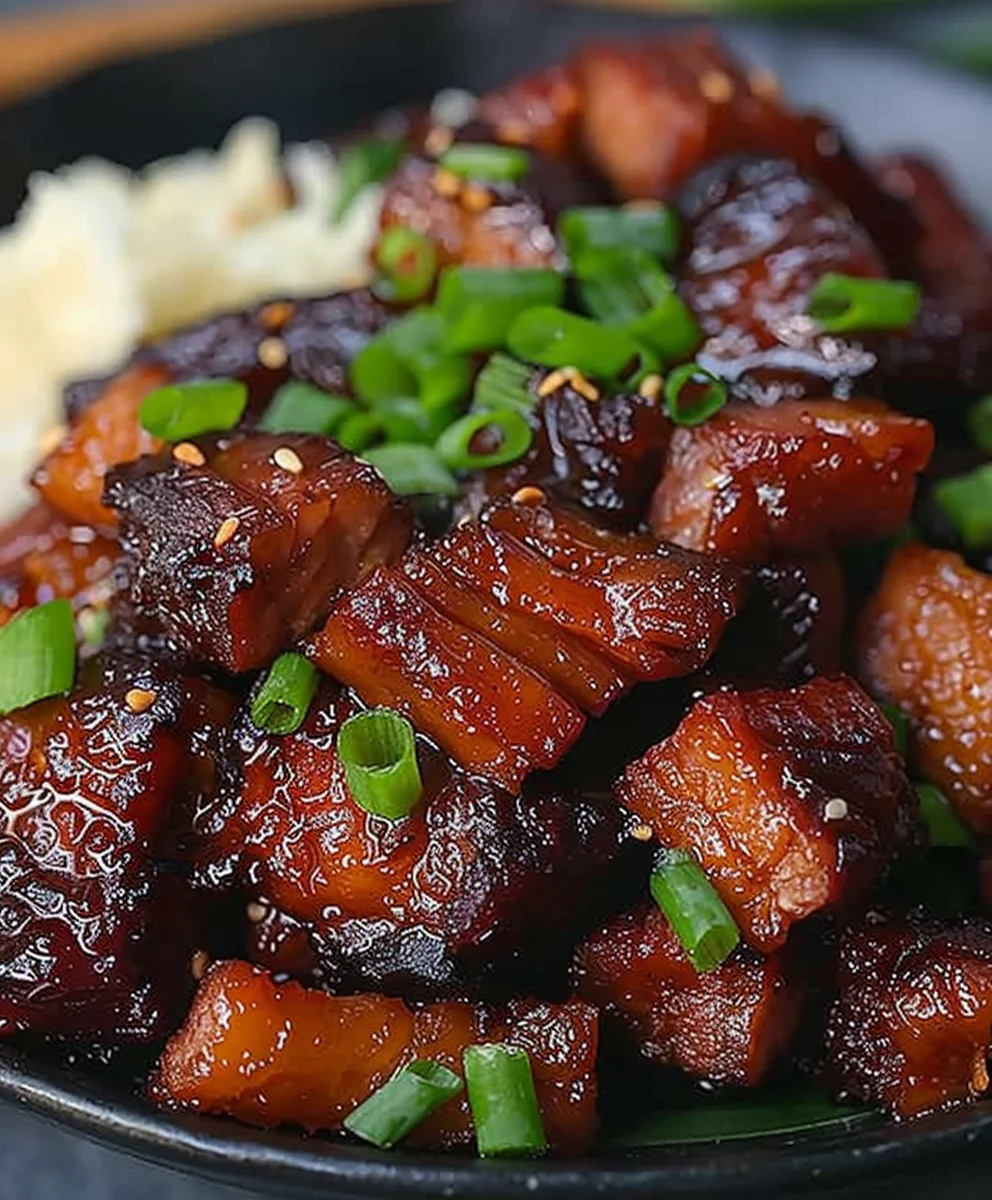Filipino Beef Tocino is more than just a dish; it’s a vibrant explosion of sweet and savory flavors that promises to transform any breakfast table into a festive spread. I’ve always been captivated by its irresistible ruby-red hue and the heartwarming aroma that fills the kitchen as it cooks, signaling the start of a truly satisfying meal. This beloved cured beef, often likened to a Filipino version of bacon, holds a uniquely cherished place in the hearts and homes of many, myself included.
Historically, tocino began as a practical method of preserving meat, a culinary innovation born out of necessity that beautifully evolved into the delightful, slightly caramelized delicacy we adore today. It stands as an indispensable component of the classic “tosilog” – an iconic breakfast triumvirate featuring tocino, sinangag (garlic fried rice), and itlog (fried egg) – perfectly encapsulating Filipino culinary comfort and tradition.
What truly makes people utterly adore Filipino Beef Tocino? It’s the exquisite balance of sweetness, derived from sugar, harmoniously blended with the savory depth of soy sauce and carefully selected spices. This marinade tenderizes the beef, resulting in incredibly succulent, slightly chewy slices that caramelize to perfection when pan-fried. The edges crisp up just right, creating a delightful textural contrast with the juicy interior. Preparing this dish from scratch might seem like a labor of love, but I promise, the unparalleled reward of homemade, perfectly seasoned tocino far outweighs the effort. Get ready to elevate your morning routine into an unforgettable feast!
Ingredients:
-
For the Beef:
- 2 pounds beef, thinly sliced against the grain (I usually go for sirloin, round, or flank steak – something that holds up well but isn’t too tough. Aim for slices about 1/4 inch thick, or even thinner if you’re really skilled with your knife).
-
For the Curing Mixture:
- 1/2 cup brown sugar, packed (dark brown sugar really gives a deeper caramel note).
- 1/4 cup white granulated sugar (for that extra sweetness and to help with the caramelization).
- 2 tablespoons coarse salt (kosher salt works beautifully here, or a fine sea salt).
- 1 teaspoon Prague Powder #1 (also known as curing salt #1 or pink curing salt. This is essential for the authentic cure, color, and safety of Filipino Beef Tocino. If you’re skipping this, understand that your tocino will be more of a sweet marinated beef, and won’t have the characteristic pink hue or extended shelf life of true cured tocino).
- 1 teaspoon freshly ground black pepper.
- 1/2 teaspoon garlic powder (while fresh garlic is great, powder helps distribute the flavor evenly during curing).
-
For the Flavoring Liquid:
- 1/4 cup soy sauce (I prefer a low-sodium one to control the saltiness, as we already have curing salt).
- 1/4 cup Anisado wine (this sweet, anise-flavored wine is traditional. If you can’t find it, a good substitute can be rice wine vinegar combined with a pinch of anise extract or even just a good quality rice wine vinegar for tenderness).
- 4-5 cloves garlic, minced very finely (fresh garlic brings such a vibrant aroma!).
- 1 teaspoon annatto powder dissolved in 2 tablespoons warm water, or 1 tablespoon annatto oil (this is purely for that signature reddish-orange color of Filipino Beef Tocino. It doesn’t add much flavor, so it’s optional if you don’t mind a paler tocino).
- 2 tablespoons water (to help combine everything and create enough liquid for the cure).
-
For Cooking:
- 2-3 tablespoons cooking oil (any neutral oil like vegetable, canola, or grapeseed).
Preparing the Beef and Curing Mixture for Filipino Beef Tocino
The journey to creating truly memorable Filipino Beef Tocino begins with careful preparation. This initial phase sets the foundation for flavor, texture, and that irresistible caramelized crust.
- Slicing the Beef: First things first, let’s get our beef ready. I always start by patting my chosen beef cut (sirloin, round, or flank work wonders) thoroughly dry with paper towels. This step is crucial because excess moisture on the surface can dilute your curing mixture and prevent it from adhering properly. Next, I lay the beef on a clean cutting board. Using a very sharp knife, I slice the beef against the grain into thin pieces, ideally about 1/4 inch thick. Slicing against the grain is incredibly important here; it shortens the muscle fibers, making the cooked tocino much more tender and enjoyable to chew. If your beef is a bit too soft to slice thinly, pop it in the freezer for 20-30 minutes to firm it up slightly. This makes slicing a breeze and allows you to achieve those beautiful, uniform slices that are characteristic of well-made Filipino Beef Tocino. Once sliced, set the beef aside.
- Combining the Dry Curing Agents: In a medium-sized bowl, I combine all the dry curing ingredients: the rich brown sugar, the bright white granulated sugar, coarse salt, Prague Powder #1, freshly ground black pepper, and garlic powder. I whisk these together thoroughly until they are uniformly mixed. This ensures that every piece of beef gets an even distribution of the curing agents, which is vital not just for flavor, but also for the proper cure and safety, especially when using Prague Powder #1.
- Preparing the Flavoring Liquid: In a separate, smaller bowl, I prepare the wet components. I pour in the soy sauce, Anisado wine (or its substitute), add the finely minced fresh garlic, and the additional two tablespoons of water. If I’m using annatto powder, I’ll have dissolved it in a separate small amount of warm water first, and then I add this vibrant red solution or the annatto oil directly into this wet mixture. I give it a good stir to ensure all the liquid ingredients are well combined. The anise flavor from the Anisado wine truly gives Filipino Beef Tocino its distinctive aromatic quality, so don’t skimp on it if you can help it!
- Marinating the Beef: Now for the fun part – bringing it all together! I place all the thinly sliced beef into a large, non-reactive bowl or a sturdy, resealable plastic bag. First, I sprinkle the dry curing mixture evenly over the beef. I use my clean hands to gently massage the dry ingredients into every piece of beef, ensuring good coverage. Then, I pour the prepared flavoring liquid over the beef. Again, I get my hands in there and massage the liquid into the beef, making sure each slice is thoroughly coated with the sweet, savory, and aromatic mixture. This hands-on approach ensures maximum flavor penetration and an even cure.
- Storing for Curing: Once every piece of beef is glistening and fully coated, I transfer the entire mixture into a clean, air-tight container or ensure the resealable bag is properly sealed, pressing out as much air as possible.
The Curing Process for Authentic Filipino Beef Tocino
The curing phase is where the magic truly happens, transforming simple beef into delicious Filipino Beef Tocino. This isn’t just a marinade; it’s a careful process that develops unique flavors, tenderizes the meat, and imparts that signature pink color. Patience is your most important ingredient here!
- Refrigeration and Turning: I place the sealed container or bag in the coldest part of my refrigerator. For optimal curing and flavor development, I let it cure for a minimum of 3 days, and ideally up to 5 days. During this time, I make sure to turn the bag or container over at least once every 12-24 hours. This redistributes the curing liquid, ensuring that every piece of Filipino Beef Tocino gets an even exposure to the cure. You’ll notice the color of the beef gradually changing to a beautiful reddish-pink hue – that’s the Prague Powder #1 doing its job, reacting with the myoglobin in the meat. This process not only cures the meat but also tenderizes it, making it incredibly succulent once cooked.
- Understanding Prague Powder #1: A quick note on Prague Powder #1: it contains sodium nitrite, which is crucial for preventing the growth of harmful bacteria, especially Clostridium botulinum, and is responsible for the characteristic pink color and cured flavor. While using it requires careful measurement (which we’ve done by specifying 1 teaspoon for 2 pounds of meat, a standard ratio), it’s a safe and effective way to achieve true cured meat. If you chose to omit it, your dish would technically be more of a sweet marinated beef rather than traditional Filipino Beef Tocino, and would not have the same safety benefits or extended shelf life, so it would need to be cooked and consumed more quickly.
- Monitoring the Cure: As the days pass, I often peek into the container just to check on the progress. The aroma will deepen, becoming a wonderful blend of sweet, savory, and garlicky notes. The beef slices will firm up slightly, and that vibrant pink will become more pronounced. Do not rush this step! The full curing period is what gives Filipino Beef Tocino its authentic taste and texture.
- Storage Post-Cure: Once the curing process is complete (after 3-5 days), if you don’t plan to cook all of it immediately, the cured tocino can be portioned and frozen for longer storage. Just make sure to wrap it tightly in freezer-safe bags or containers. This makes it super convenient to pull out a portion whenever you crave a delicious Filipino breakfast.
Cooking Your Delicious Filipino Beef Tocino
After the patient wait during the curing process, it’s finally time to cook your homemade Filipino Beef Tocino! This step is all about achieving that perfect balance of tender, slightly chewy meat with a deliciously caramelized, sticky glaze.
- Preparing for Cooking: When you’re ready to cook, retrieve the desired amount of cured Filipino Beef Tocino from the refrigerator. If it was frozen, make sure to thaw it completely in the refrigerator beforehand. I usually take it out about 30 minutes before cooking to let it come closer to room temperature, which helps it cook more evenly.
- The Initial Simmer: This is a crucial step for tenderness and flavor. In a non-stick skillet or a wide, shallow pan, arrange the tocino slices in a single layer. Add about 1/4 cup of water to the pan – just enough to barely cover the bottom. I also like to add a tablespoon or two of the remaining curing liquid from the container; this adds an extra layer of flavor and helps create that beautiful glaze. Place the pan over medium-low heat. Bring the water to a gentle simmer, then cover the pan and let the tocino cook in its own juices and the added liquid for about 5-7 minutes. This slow simmer tenderizes the meat beautifully and allows the sugars to penetrate deeper, ensuring a succulent bite. You’ll see the liquid start to reduce, and the tocino will soften.
- Reducing and Glazing: After 5-7 minutes, remove the lid. Increase the heat slightly to medium. The goal now is to allow the water to evaporate completely. As the water reduces, the sugars and other curing agents in the liquid will begin to thicken and create a delicious syrupy glaze around the tocino. Keep an eye on it during this stage, stirring occasionally to prevent sticking.
- Frying to Perfection: Once the water has almost completely evaporated and the sauce has thickened into a glossy syrup, add 2-3 tablespoons of cooking oil to the pan. The amount might vary slightly depending on how much fat renders from your beef, but generally, 2-3 tablespoons is a good starting point. Increase the heat to medium-high. Now, we’re going to fry the Filipino Beef Tocino until it’s beautifully caramelized and slightly crispy. Fry each side for 2-3 minutes, or until you achieve that coveted golden-brown, slightly sticky exterior. Be careful not to overcook it! The sugars can burn quickly, so keep a close watch and adjust the heat as needed. You want a lovely glaze, not a charred mess. The aroma at this stage is absolutely heavenly – sweet, savory, and deeply aromatic.
- Checking for Doneness: The tocino should be tender inside with a delightful chew, and the edges should be slightly crisped and caramelized. If you’re unsure, you can always take a small piece out to taste. The internal temperature for beef is usually around 145°F (63°C) for medium-rare, but with tocino, the visual cues of caramelization and tenderness are often more important for achieving the desired texture.
Serving Suggestions and Enjoyment
Congratulations! You’ve successfully prepared homemade Filipino Beef Tocino. Now comes the best part – enjoying the fruits of your labor! This dish is a cornerstone of the classic Filipino breakfast, and there are traditional ways to serve it that truly elevate the experience.
-
The Classic Filipino Breakfast Plate (Tosilog): The most iconic way to enjoy Filipino Beef Tocino is as part of a “Tosilog” meal. This delightful combination includes:
- Sinangag (Garlic Fried Rice): A generous serving of freshly made garlic fried rice is absolutely essential. The savory, garlicky rice provides a wonderful counterpoint to the sweet and slightly salty tocino.
- Pritong Itlog (Fried Egg): A sunny-side-up fried egg, with its runny yolk, is the perfect accompaniment. The rich yolk, when mixed with the tocino and rice, creates a symphony of flavors and textures. Some people prefer scrambled eggs, and that’s perfectly fine too!
- Atchara (Pickled Papaya): To cut through the richness and sweetness of the tocino, a small side of atchara (pickled green papaya) is traditionally served. Its tangy, slightly sweet, and crunchy profile offers a refreshing contrast.
This trio creates a balanced, hearty, and incredibly satisfying meal that truly showcases the essence of Filipino breakfast. The flavors of the sweet and savory tocino, the aromatic garlic rice, and the rich egg yolk blend together seamlessly, making every bite a delight. I often find myself craving this combination specifically for that reason.
-
Other Serving Ideas: While tosilog is king, your homemade Filipino Beef Tocino is versatile!
- With Plain Rice: If you’re short on time or prefer something simpler, serving it with just steamed white rice is still incredibly delicious. The rice soaks up all the wonderful juices and glazes from the tocino.
- As a Sandwich Filling: For a quick lunch, chop up some cooked tocino and put it in a bun or pandesal (Filipino sweet roll) with a fried egg. It’s surprisingly good!
- With Fresh Tomatoes: A simple side of sliced fresh tomatoes adds a nice acidic freshness, much like atchara, if you don’t have the latter on hand.
- Enjoying the Moment: Serve your beautiful Filipino Beef Tocino immediately while it’s still warm and the glaze is perfectly sticky and glossy. Gather your loved ones around the table and savor this truly authentic taste of the Philippines. There’s nothing quite like the satisfaction of enjoying homemade Filipino Beef Tocino, knowing you’ve crafted every delicious bite yourself! This recipe provides not just a meal, but a comforting experience that brings a little bit of Filipino culinary heritage right into your home kitchen.
After diving deep into the delightful process of creating this iconic dish, I truly hope you’re feeling inspired and excited to bring its vibrant flavors into your own kitchen. This isn’t just any recipe; it’s an invitation to experience a culinary tradition that’s cherished by so many. What makes this particular version of Filipino Beef Tocino an absolute must-try, in my humble opinion, is the perfect marriage of tender, thinly sliced beef with that irresistible sweet and savory glaze. It’s a delicate balance that tantalizes the taste buds, offering a unique profile that sets it apart from your everyday breakfast meats. The beautiful reddish-orange hue, achieved through natural means, is as appealing to the eyes as the succulent taste is to the palate. I promise you, the aroma alone as it sizzles gently in the pan is enough to make anyone’s mouth water, filling your home with a comforting and exotic scent that hints at the deliciousness to come. It truly elevates a simple meal into something extraordinary, a testament to the power of thoughtful marination and careful cooking.
My goal with this recipe was to demystify the process, showing you how straightforward it can be to achieve restaurant-quality tocino right at home, without any artificial fuss. The joy of pulling that first batch from the pan, seeing the caramelized edges, and knowing you created something so incredibly delicious from scratch, is truly immeasurable. It’s a dish that embodies comfort, warmth, and the simple pleasures of a good meal shared with loved ones. Once you taste that perfect bite—sweet, savory, and incredibly tender—you’ll understand why this recipe holds such a special place in my heart and, I believe, will quickly find a permanent spot in your rotation too. It’s more than just food; it’s an experience, a moment of culinary bliss that brightens any morning or even an evening meal.
Serving Suggestions & Delightful Variations:
Now, let’s talk about how to truly savor your homemade tocino. While it’s utterly fantastic on its own, traditionally, Filipino Beef Tocino is best enjoyed as part of a “silog” meal. This means serving it alongside a generous portion of steaming hot garlic fried rice, known as sinangag, and a perfectly fried egg, ideally sunny-side up with a runny yolk that coats the rice and beef beautifully. The combination of the sweet tocino, pungent garlic rice, and rich egg yolk creates a symphony of flavors and textures that is truly unparalleled. For an authentic touch, I highly recommend adding a side of pickled papaya relish, or atchara. Its tangy, slightly sweet, and crunchy profile cuts through the richness of the tocino and rice, providing a refreshing contrast that rounds out the entire meal perfectly. Trust me, these three elements together create a harmonious breakfast or brunch that will transport you straight to the Philippines.
But don’t stop there! The versatility of this delicious meat opens up a world of possibilities beyond the traditional plate. Consider dicing your cooked tocino and adding it to a breakfast burrito or taco for a sweet and savory kick. Imagine a tocino fried rice bowl, where the chopped tocino is stirred right into the garlic rice with some sautéed vegetables like peas and carrots, creating a hearty one-bowl meal. You could even create a unique tocino sandwich, perhaps with a soft brioche bun, a fried egg, and a touch of a spicy aioli for an unexpected fusion twist. For those who love a little heat, a pinch of red pepper flakes in the marinade or a dash of your favorite hot sauce drizzled over the cooked tocino can add an exciting layer of spice. You might also experiment with different cuts of beef, though I find thin slices of sirloin or even beef belly work wonders for that ideal texture. The beauty of cooking at home is the freedom to customize, to make it truly your own.
So, there you have it! My sincerest hope is that this recipe inspires you to roll up your sleeves and give this incredible dish a try. It’s a rewarding culinary adventure that promises big flavors and even bigger smiles. Don’t be shy; embrace the process, enjoy the vibrant aromas, and most importantly, savor every single bite. I truly believe that once you experience the homemade difference, you’ll never go back to store-bought. It’s a truly special dish, simple to master, and incredibly satisfying.
I would absolutely love to hear about your experience! Did you stick to the traditional “silog” or did you get creative with a unique serving suggestion? Did you make any exciting adjustments to the marinade? Please, please, please share your cooking journey, your photos, and any delightful variations you come up with in the comments below. Your insights and culinary experiments are what make our cooking community so vibrant and inspiring. Thank you for joining me on this delicious journey. Happy cooking, and enjoy every flavorful moment!

Filipino Beef Tocino: Sweet & Savory Homemade Recipe
Filipino Beef Tocino is a vibrant explosion of sweet and savory flavors, transforming any breakfast. This beloved cured beef, akin to Filipino bacon, is indispensable for the classic ‘tosilog’ (tocino, sinangag, itlog). Its exquisite balance of sweetness, savory soy, and spices tenderizes the beef, creating succulent, caramelized slices. Homemade tocino offers an unparalleled reward.
Ingredients
-
1 lb beef (sirloin, round, or flank), thinly sliced against the grain
-
½ cup brown sugar, packed
-
2 tablespoons coarse salt
-
1 teaspoon Prague Powder #1 (curing salt #1)
-
1 teaspoon freshly ground black pepper
-
½ teaspoon garlic powder
-
¼ cup soy sauce
-
¼ cup pineapple juice
-
4-5 cloves garlic, minced very finely
-
1 teaspoon annatto powder dissolved in 2 tablespoons warm water, or 1 tablespoon annatto oil
-
1 tablespoon water
-
2-3 tablespoons cooking oil
Instructions
-
Step 1
Pat beef dry. Slice against the grain into 1/4 inch thick pieces. If too soft, freeze for 20-30 minutes for easier slicing. -
Step 2
In a medium bowl, whisk together brown sugar, coarse salt, Prague Powder #1, black pepper, and garlic powder until uniformly mixed. -
Step 3
In a separate small bowl, combine soy sauce, pineapple juice, minced garlic, annatto solution/oil, and water. Stir well. -
Step 4
Place sliced beef in a large bowl or resealable bag. Sprinkle dry curing mixture evenly over beef and massage. Pour flavoring liquid over beef and massage until each slice is thoroughly coated. -
Step 5
Transfer beef to an airtight container or properly sealed bag. Refrigerate for a minimum of 3 days, ideally up to 5 days, turning the container/bag every 12-24 hours to ensure even curing. The beef’s color will gradually change to a reddish-pink hue. -
Step 6
When ready to cook, retrieve desired amount (thaw if frozen). Arrange tocino slices in a single layer in a non-stick skillet. Add about 1/4 cup water and 1-2 tablespoons of the remaining curing liquid. Cover and simmer over medium-low heat for 5-7 minutes until the meat tenderizes and liquid begins to reduce. -
Step 7
Remove lid and increase heat slightly to medium. Allow the water to evaporate completely, stirring occasionally. The sugars will thicken, creating a delicious syrupy glaze around the tocino. -
Step 8
Once water has almost completely evaporated and sauce has thickened, add 2-3 tablespoons cooking oil. Increase heat to medium-high. Fry each side for 2-3 minutes, or until beautifully caramelized, golden-brown, and slightly crispy. Watch carefully to prevent burning. -
Step 9
Serve immediately while warm. For a classic ‘Tosilog’, pair with sinangag (garlic fried rice) and pritong itlog (fried egg). A side of atchara (pickled papaya) or fresh tomatoes adds a refreshing contrast. Enjoy!
Important Information
Nutrition Facts (Per Serving)
It is important to consider this information as approximate and not to use it as definitive health advice.
Allergy Information
Please check ingredients for potential allergens and consult a health professional if in doubt.





Leave a Comment